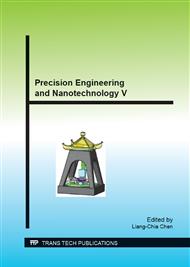p.129
p.134
p.140
p.149
p.155
p.161
p.167
p.172
p.178
Diffusion Wear Mechanism of Single Crystal Diamond Tool in Machining Die Steels
Abstract:
Ultra-precision diamond cutting of ferrous metals has not been successful in application due to significant tool wear. In this work, numerical simulations and experimental investigations are presented in order to study the interface diffusion between diamond tool and workpiece materials. A diffusion model with respect to carbon atoms from diamond tool penetrating into chips and machined surface was established. The numerical simulation results of the diffusion process reveal that the distribution laws of carbon atoms concentration have a close relationship with diffusion distance, diffusion time and the original carbon concentration of the work material. In addition, diamond face cutting tests of die steels with different carbon content are conducted at different depth of cuts and feed rates to verify the previous simulation results. The wear morphology of rake face and flank face of diamond tool were detected by scanning electron microscopy. Energy dispersive X-ray analysis was proposed to investigate the change in chemical composition of the chips and machined surface. The results of this work benefit for a better understanding on the diffusion wear mechanism in single crystal diamond cutting of ferrous metals.
Info:
Periodical:
Pages:
155-160
Citation:
Online since:
August 2014
Keywords:
Price:
Сopyright:
© 2015 Trans Tech Publications Ltd. All Rights Reserved
Share:
Citation:


